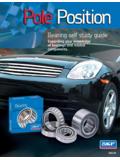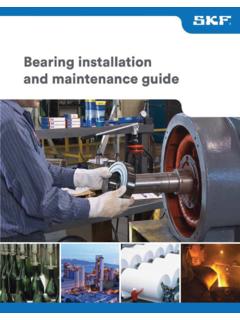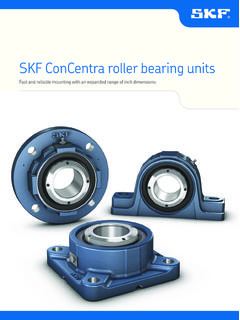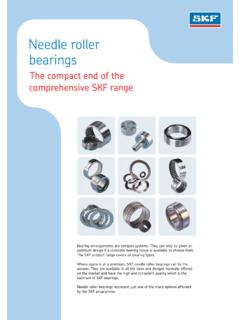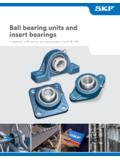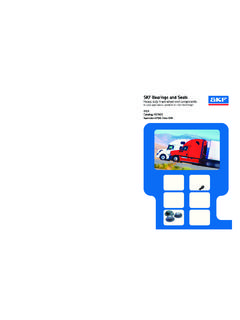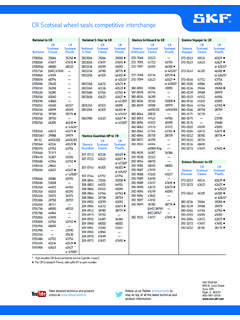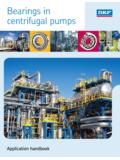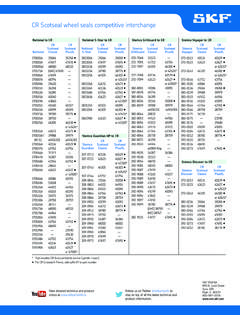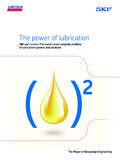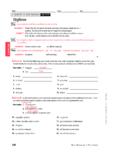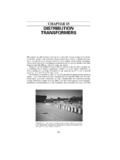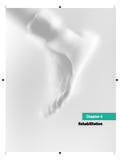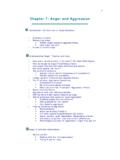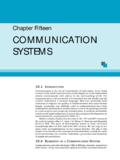Transcription of Automotive Seals Self-Study Guide - SKF.com
1 Automotive Seals Self-Study Guide Expanding your knowledge of Seals and related componentsTABLE OF CONTENTSI ntroduction .. 4 Chapter 1: The Shaft seal .. 6 seal /Components .. 8 How the seal Works.. 8 Review.. 10 Chapter 2: Sealing Element (Lip) Materials .. 12 Synthetics .. 12 Non-Synthetics .. 16 The Waveseal .. 18 Review .. 19 Chapter 3: seal Selection .. 21 Replacement Seals .. 21 seal Substitutions .. 21 Seals for New Applications .. 22 Measuring seal Size .. 23 Pressure/Temperature/Fluid Compatibility.. 24 Review .. 25 Chapter 4: Pre-Installation Requirements .. 27 Shaft Requirements .. 27 Bore Requirements.
2 30 Pre-Lubrication .. 32 Tools .. 32 Review .. 35 Chapter 5: Grease seal Installation .. 37 Front Axle .. 37 Installation Checklist .. 39 Drive Axle .. 40 Review .. 42 Chapter 6: Troubleshooting .. 44 Preliminary Survey .. 44 seal Markings/Cocked seal .. 44 Operating Temperature/Excessive Pressure. 45 Incorrect Lubricant .. 46 Review .. 47 Chapter 7: Wear Sleeves .. 49 Speedi-Sleeves .. 49 Speedi-Sleeve Installation .. 50 Review .. 52 Chapter 8: Rear Wheel seal and PinionInstallation .. 54 Bearing/ seal Removal .. 54 Bearing/ seal Installation .. 55 Pinion seal Replacement .. 57 Review.. 604 INTRODUCTIONThis book, produced for use by SKF distributors and customers, should prove of practical value to engineers, fleetmechanics, maintenance superintendents and anyone who canbenefit from a thorough understanding of Seals .
3 It will explain: How to select the best seal for any given application; How to improve performance with proper installation; How to spot and correct seal problems withthe least possible amount of time and to Use this study GuideThis Self-Study Guide is programmed to increase performanceproductivity. Each chapter consists of a logical organization ofmaterial, technical diagrams and a short quiz to help you retainwhat you by carefully reading the text portion of each notes or underline if you wish; this can help you remember what you ve does not matter whether you are a fast or slow learner. At the end of the program, you will have learned the sameinformation and should retain it as well as any other student.
4 The chapter quizzes are an important phase in self -studylearning since they are intended to reinforce the material covered. The quiz questions are straightforward multiple choiceand true-false. There are no trick questions. Your answers caneasily be checked within the context of the each review in order before going on to the nextchapter. If you are not sure of an answer to a question, checkback in the chapter and review that portion History of the Shaft SealSKF invented and patented the first integrated shaft seal in1928. It was designed to hold grease in automobile the mid 1930 s, SKF pioneered the development of customformulating, compounding and molding elastomers (syntheticrubber).
5 This led to other innovations in manufacturingprocesses, new sealing techniques, and the compounding andmolding of various elastomer , SKF is the world s leading supplier of fluid sealingdevices for the truck, Automotive , farm equipment, aircraft,heavy machinery and machine tool also supplies Seals for aerospace missiles, earthmovingequipment, appliances, and a wide variety of pumps, hydraulicsystems, motors and can supply more than 200 types of Seals in more than3,000 stock sizes. That includes Seals in both bonded and assembled designs, with single or double lip elements, and with or without spring-loading or inner Seals fit shaft diameters from.
6 188" to over 180". All arefashioned from a large and ever-growing spectrum of sealingelements and case SHAFT SEALIn this world of moving parts, whenever a shaft rotates, it needs a bearing for smooth, effective most cases, where there s a bearing, you ll find a seal helping it to do its job better. In simple terms, a shaft seal is a Seals are designed to: Retain lubricants or liquids Confine pressure Exclude dirt Separate fluidsSeals are necessary for sealing in lubricants that are needed to protect the bearings and to seal out dirt, waterand contaminants. To do both jobs effectively, all Seals demandprecise engineering and designs and materials are constantly being developed,tested and improved.
7 This testing is being done to conform withtoday s increased performance and durability material being sealed can be anything from light oil toheavy grease, or even hot turbine gases. Wheel Seals areamong the most common applications. The seal retains lube inthe bearing, and at the same time, protects the bearing from contaminants such as water, dirt, dust and , it must be decided which is more important: retentionof lubricant, exclusion of foreign matter or, in some cases, the seal s basic job is to retain, the lip of the seal mustface toward the lubricant or pressure being retained (fig. 1).ExclusionMore bearings fail from the entrance of foreign material than from the loss of lubricant.
8 Dirt, abrasives, water and otherliquids can all interfere with the film of lubricant which supportsthe moving parts of a bearing in a sealed , it is vitally important for the seal to keep these materials from entering the bearing cavity. To do this best, the lip of the seal should face toward the contaminants instead oftoward the bearing (fig. 2).Retention Seals retain lubricants. (fig. 1)Exclusion Seals prevent dirtfrom entering the bearingcavity. (fig. 2)7 Retention/ExclusionMany applications require the seal to perform both the retention and exclusion functions at the same time. Forexample, the seal may need to confine a lubricant, as well asexclude road dust, mud, water, or other highway applications that require both lube retention and dirtexclusion, a special type of protection is needed, either a combination of two Seals , or dual sealing elements within oneassembly (fig.)
9 3).The kind of seal (grease vs. oil, for example) depends on thelocation and function of the seal . The diagram below shows thelocation of the most commonly replaced oil Seals on vehiclesand trucks (fig. 4). Two Seals placed back-to-backretain lubricant and exclude dirtsimultaneously. (fig. 3)1 Typical seal & Bearing Locations(4WD Passenger & 4WD Lt. Truck)Typical seal & Bearing Locations( Passenger)(Fig. 4)8 seal DesignThe shaft seal is a small and simple looking product with a big andimportant job. The following describes a typical seal and the functionof each of its components (fig. 5). seal Components1. Outer Shell (Case).
10 The outer, cup-shaped, rigid structure ofthe lip seal assembly acts as a protective cover for the head ofthe sealing element and more importantly holds the installedseal in Inner Shell (Case).A rigid cup-shaped component of a sealassembly which is placed inside the outer seal case. It can function as a reinforcing member, shield, spring retainer orlip-clamping Sealing flexible elastomeric working componentof a lip seal assembly which rides against the Primary flexible elastomeric component of the sealing element which contacts the rotating Secondary Lip (Auxiliary Lip).A short, non-spring-loaded lip of the sealing element which is located at the outside sealface of a radial lip seal .
